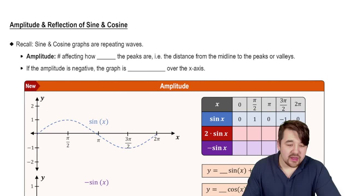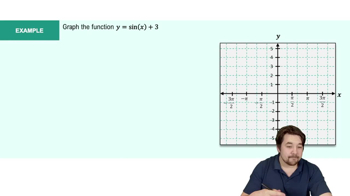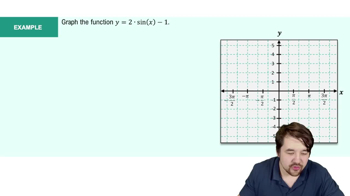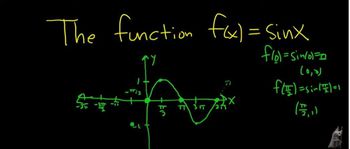Table of contents
- 0. Review of College Algebra4h 43m
- 1. Measuring Angles39m
- 2. Trigonometric Functions on Right Triangles2h 5m
- 3. Unit Circle1h 19m
- 4. Graphing Trigonometric Functions1h 19m
- 5. Inverse Trigonometric Functions and Basic Trigonometric Equations1h 41m
- 6. Trigonometric Identities and More Equations2h 34m
- 7. Non-Right Triangles1h 38m
- 8. Vectors2h 25m
- 9. Polar Equations2h 5m
- 10. Parametric Equations1h 6m
- 11. Graphing Complex Numbers1h 7m
4. Graphing Trigonometric Functions
Graphs of the Sine and Cosine Functions
Problem 4.26
Textbook Question
Graph each function over a one-period interval.
y = -2 cos x
 Verified step by step guidance
Verified step by step guidance1
Identify the basic cosine function: The basic cosine function is \( y = \cos x \), which has a period of \( 2\pi \).
Determine the amplitude: The given function is \( y = -2 \cos x \). The amplitude is the absolute value of the coefficient of \( \cos x \), which is 2. The negative sign indicates a reflection over the x-axis.
Identify the period: The period of \( \cos x \) is \( 2\pi \). Since there is no horizontal stretching or compression (no coefficient inside the cosine function), the period remains \( 2\pi \).
Determine the phase shift and vertical shift: There is no horizontal or vertical shift in the function \( y = -2 \cos x \), so the graph starts at the origin.
Graph the function: Start by plotting the key points of the cosine function over one period \([0, 2\pi]\). Reflect these points over the x-axis and scale them by the amplitude of 2. The key points are \((0, -2), (\pi/2, 0), (\pi, 2), (3\pi/2, 0), (2\pi, -2)\).
Recommended similar problem, with video answer:
 Verified Solution
Verified SolutionThis video solution was recommended by our tutors as helpful for the problem above
Video duration:
0m:0sPlay a video:
Was this helpful?
Key Concepts
Here are the essential concepts you must grasp in order to answer the question correctly.
Cosine Function
The cosine function, denoted as cos(x), is a fundamental trigonometric function that represents the x-coordinate of a point on the unit circle corresponding to an angle x. It oscillates between -1 and 1, with a period of 2π, meaning it completes one full cycle every 2π radians. Understanding its shape and behavior is crucial for graphing transformations.
Recommended video:

Graph of Sine and Cosine Function
Amplitude
Amplitude refers to the maximum distance from the midline of a periodic function to its peak or trough. In the function y = -2 cos x, the amplitude is 2, indicating that the graph reaches a maximum value of 2 and a minimum value of -2. The negative sign indicates a reflection over the x-axis, altering the direction of the peaks and troughs.
Recommended video:

Amplitude and Reflection of Sine and Cosine
Graphing Transformations
Graphing transformations involve modifying the basic shape of a function through shifts, stretches, compressions, and reflections. In the case of y = -2 cos x, the graph is vertically stretched by a factor of 2 and reflected across the x-axis. Understanding these transformations is essential for accurately sketching the graph over a specified interval.
Recommended video:

Introduction to Transformations

 5:53m
5:53mWatch next
Master Graph of Sine and Cosine Function with a bite sized video explanation from Nick Kaneko
Start learningRelated Videos
Related Practice
















